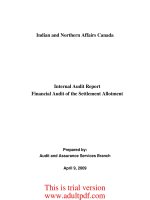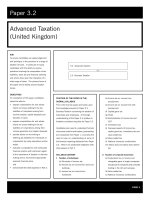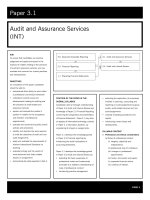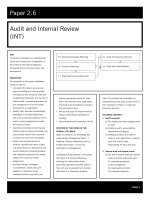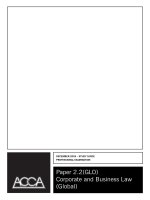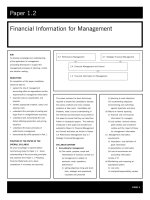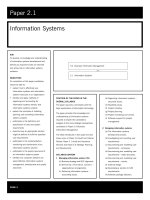acca test book Audit and Assurance Services pot
Bạn đang xem bản rút gọn của tài liệu. Xem và tải ngay bản đầy đủ của tài liệu tại đây (367.02 KB, 12 trang )
PAGE 3
Paper 3.1
Audit and Assurance Services
(INT)
3.6 Advanced Corporate Reporting
3.1 Audit and Assurance Services
2.5 Financial Reporting
1.1 Preparing Financial Statements
2.6 Audit and Internal Review
AIM
To ensure that candidates can exercise
judgement and apply techniques in the
analysis of matters relating to the provision
of audit and assurance services, and can
evaluate and comment on current practices
and developments.
OBJECTIVES
On completion of this paper candidates
should be able to:
• demonstrate their ability to work within
a professional and ethical framework
• understand current issues and
developments relating to auditing and
the provision of audit-related and
assurance services
• explain and evaluate the auditor’s
position in relation to the acceptance
and retention of professional
appointments
• evaluate and recommend quality control
policies and procedures
• identify and describe the work required
to meet the objectives of audit and non-
audit assignments
• apply and evaluate the requirements of
relevant International Standards on
Auditing
• evaluate findings and the results of
work performed and draft suitable
reports on assignments
• demonstrate the skills expected in Part 3.
POSITION OF THE PAPER IN THE
OVERALL SYLLABUS
Candidates need a thorough understanding
of Paper 2.6 Audit and Internal Review and
knowledge of Paper 2.5 Financial Reporting
concerning the preparation and presentation
of financial statements. Paper 3.1 may draw
on aspects of information technology, covered
in Paper 2.1 Information Systems, by
considering its impact on assignments.
Paper 3.1 develops the knowledge gained
in Paper 2.5 Financial reporting by
introducing the audit implications of
accounting treatments.
Paper 3.1 develops the knowledge gained
in Paper 2.6 Audit and Internal Review by:
• extending the basic awareness of
professional codes and fundamental
principles to a detailed understanding of
rules of professional conduct
• introducing practice management
• extending the application of procedures
involved in planning, conducting and
reporting on audit assignments to group
audits, audit-related services and non-
audit assignments
• critically evaluating procedures and
reports
• introducing current issues and
developments.
SYLLABUS CONTENT
1 Professional and ethical considerations
(a) Rules of professional conduct
(i) integrity, objectivity and
independence
(ii) professional duty of confidence
(iii) changes in professional
appointments
(iv) books, documents and papers
(v) corporate financial advice
(vi) conflicts of interest.
PAGE 4
(b) Professional responsibility and liability
(i) fraud and error
(ii) professional liability (including
negligence)
(iii) misconduct
(iv)expectation gap
(v) professional indemnity insurance
(vi)insider dealing.
(c) Regulatory environment
(i) corporate governance
(ii) Code of Best Practice
(iii) audit committees
(iv) internal financial control
effectiveness
(v) laws and regulations in an audit
of financial statements.
2 Practice management
(a) Quality control practices and
procedures.
(b) Advertising, publicity and obtaining
professional work.
(c) Fees.
(d) Tendering.
(e) Terms of engagement.
3 Audit process
(a) Audit strategy including
(i) risk-based auditing
(ii) systems audits
(iii) balance sheet approach
(iv) revenue, expenditure and other
cycles
(v) directional testing
(vi) analytical procedures.
(b) Planning including
(i) materiality
(ii) risk assessments.
(c) Evidence including
(i) documentation
(ii) related parties
(iii) management representations
(iv) using the work of others.
(d) Evaluation and review including
(i) opening balances and
comparatives
(ii) other information
(iii) subsequent events
(iv) going concern.
4 Assignments
(a) Audit of financial statements.
(b) Group audits.
(c) Audit-related services including:
(i) reviews
(ii) agreed-upon procedures
(iii) compilations.
(d) Assurance services including:
(i) risk assessment
(ii) performance measurement
(iii) systems reliability
(iv) electronic commerce.
(e) Prospective financial information.
(f) Internal audit.
(g) Outsourced finance and accounting
functions.
(h) Social and environmental audits.
5 Reporting
(a) Auditor’s reports.
(b) Conclusions and reporting for
agreed-upon procedures and
assurance services.
(c) Reports to management.
6 Current issues and developments
(a) Professional ethics.
(b) Corporate governance.
(c) Fraud.
(d) Environmental issues.
(e) Information technology.
(f) Multinational accountancy firms.
(g) SMEs and audit exemption.
EXCLUDED TOPICS
The following topics are specifically
excluded from the syllabus:
• Stock Exchange Listing Requirements
• International Accounting Standards
Exposure Drafts
• effects on a company of insolvency law
and of employment and social security
law (e.g. wrongful trading and national
insurance contributions).
KEY AREAS OF THE SYLLABUS
The key topic areas are as follows:
• rules of professional conduct
• quality control practices and procedures
• audit strategy
• assignments
• auditor’s reports
• current issues and developments.
Audit and Assurance Services (INT) (Continued)
PAGE 5
APPROACH TO EXAMINING THE
SYLLABUS
The examination is a three hour paper
constructed in two sections. Questions in
both sections will be almost entirely
discursive. However, candidates will be
expected, for example, to be able to assess
materiality and calculate relevant ratios
where applicable.
Section A questions will be based on ‘case
study’ type scenarios. That is not to say
that they will be particularly long, rather
that they will provide a setting within
which a range of topics, issues and
requirements can be addressed. Different
types of question will be encountered in
Section B and will tend to be more
focussed on specific topics, for example
‘auditor’s reports’, ‘quality control’ and
topics of ISAs which are not examinable in
Paper 2.6 Audit and Internal Review. (This
does not preclude these topics from
featuring in Section A.) These questions
will have less scenario than in Section A
and one will be a discussion question.
Number
of marks
Section A: 3 compulsory questions 70
Section B: Choice of 2 from 3
questions (15 marks each) 30
100
ADDITIONAL INFORMATION
Candidates need to be aware that questions
involving knowledge of new examinable
regulations will not be set until at least six
months after the last day of the month in
which the regulation was issued.
The Study Guide provides more detailed
guidance on the syllabus. Examinable
documents are listed in the ‘Exam Notes’
section of student accountant.
RELEVANT TEXTS
There are a number of sources from which
you can obtain a series of materials written
for the ACCA examinations. These are
listed below:
Foulks Lynch – ACCA's official publisher
Contact number: +44 (0)20 8831 9990.
Website: www.foulkslynch.com
Accountancy Tuition Centre (ATC)
International
Contact number: +44 (0)141 880 6469.
Website: www.ptc-global.com
BPP
Contact number: +44 (0)20 8740 2211.
Website: www.bpp.com
The Financial Training Company
Contact number: +44 (0)174 785 4302.
Website: www.financial-training.com
Wider reading is also desirable, especially
regular study of relevant articles in ACCA's
student accountant.
Audit and Assurance Services (INT) (Continued)
STUDY SESSIONS
1 Rules of professional conduct I
Candidates should be able to interpret,
apply and appraise specified statements
of professional ethics which govern the
auditor’s conduct and are included in
ACCA’s ‘Rules of Professional Conduct’
and IFAC’s ‘Code of Ethics for
Professional Accountants’.
(a) Integrity, objectivity and
independence
(i) revise the purpose of a professional
ethical code from Paper 2.6
(ii) compare and contrast the
Fundamental Principles of ACCA’s
‘Rules of Professional Conduct’
with those of IFAC’s ‘Code of Ethics
for Professional Accountants’
(iii) outline the contents of ACCA’s
and IFAC’s codes of ethics
(iv) identify and explain common
threats to independence and
explain how the risks may be
minimised or resolved
(v) discuss and evaluate the
effectiveness of available
safeguards
(vi) outline the practical implications
for an audit practice in relation to
quality control procedures
These articles and other communications
from the examination can be downloaded via
the Students section of www.accaglobal.com.
PAGE 6
Audit and Assurance Services (INT) (Continued)
(vii) discuss the benefits of providing
other services (including internal
audit) to audit clients and whether
the drawbacks (eg objectivity
impairment) can be overcome
(viii) define “specialist valuations”
and discuss how the objectivity
of the audit may be threatened
(ix)explain how and why an auditor
should respond to a request to
provide a second opinion
(b) Professional duty of confidence
(i) explain the importance of the role
of confidentiality to the auditor-
client relationship
(ii) distinguish between disclosure
and use of information
(iii) identify circumstances in which
disclosure is permitted or required
(iv) discuss the factors which may
justify disclosure in the “public
interest”
(v) describe how a client’s
information should be protected
when the auditor also acts for a
competitor company
2 Rules of professional conduct II
(a) Changes in professional appointments
(i) discuss the reasons why entities
change their auditors
(ii) explain the matters to be
considered and the procedures
which an audit firm/professional
accountant should carry out
before accepting new clients and
new engagements
(iii) describe the procedures for
agreeing the terms of an
engagement
(iv) outline the procedures for the
transfer of books, papers and
information following a new
appointment
(b) Books, documents and papers
(i) explain the general principals
governing the ownership of, and
rights of access to, documents
and papers
(ii) explain the legal right of lien and
describe the circumstances in
which it may be exercised
(iii) discuss the extent to which
clients and third parties may
have access to documents and
papers
(c) Corporate financial advice and
conflicts of interest
(i) outline the role of auditors in
advising clients involved in take-
over bids and share issues and
explain how conflicts can arise
(ii) distinguish conflicts between
members’ and clients’ interests
from those between the interests
of different clients
(iii) describe how conflicts may be
avoided or managed with
safeguards
3 Professional responsibility and liability
(a) Fraud and error
(i) define and distinguish between
the terms “error”, “irregularity”,
“fraud” and “misstatement”
(ii) compare and contrast the
respective responsibilities of
management and auditors for
fraud and error
(iii) describe the matters to be
considered and procedures to be
carried out to investigate actual
and/or potential misstatements
(iv) explain how, why, when and to
whom fraud and error should be
reported and the circumstances
in which an auditor should
withdraw from an engagement
(v) discuss the current and possible
future role of auditors in
preventing, detecting and
reporting error and fraud
(b) Professional Liability
(i) identify the circumstances in which
auditors may have legal liability
(ii) describe the factors to determine
whether or not an auditor is
negligent in given situations
(iii) explain the other criteria for legal
liability to be recognised
(including “due professional care”
and “proximity”)
(iv) distinguish between liability to
client and liability to third parties
(v) comment on precedents of case law
(vi) identify and evaluate the
practicability and effectiveness of
ways in which liability may be
restricted
(vii) discuss how the audit and other
opinions may be affected by
PAGE 7
Audit and Assurance Services (INT) (Continued)
limiting audit liability
(viii) discuss the advantages and
disadvantages of audit liability
claims being settled out of court
(c) Misconduct
(i) explain and illustrate what is meant
by professional misconduct
(ii) outline the penalties and
sanctions which may be imposed
by disciplinary bodies
(d) Expectation gap
(i) identify and discuss the factors
which contribute to the expectation
gap (e.g. responsibilities for fraud
and error, litigation)
(ii) suggest ways in which the gap
might be bridged
(e) Professional indemnity insurance
(i) explain the terms professional
indemnity insurance (PII) and
fidelity guarantee insurance (FGI)
(ii) discuss arguments for and
against mandatory cover
(f) Insider dealing
(i) explain the term “insider dealing”
and why it is damaging
(ii) relate the Fundamental Principles
to insider dealing
(iii) suggest measures to reduce the
exposure of partners and staff to
the risks arising
4 Regulatory environment
Revision of Regulatory Framework from
Paper 2.6
(a) Corporate governance
(i) explain the objective, relevance
and importance of corporate
governance
(ii) discuss the relative merits and
disadvantages of voluntary codes
and legislation
(iii) discuss current issues in
corporate governance
(b) Code of Best Practice
(i) outline the provisions of the Code
of Best Practice (based on the
Cadbury Report) that are most
relevant to auditors
(ii) outline the requirements of the
Combined Code (of the Committee
on Corporate Governance) relating
to directors’ responsibilities (e.g. for
risk management and internal
control) and the reporting
responsibilities of auditors
(iii) outline the content of a
corporate governance statement
(c) Audit Committees
(i) explain the structure and roles of
audit committees and discuss
their benefits and drawbacks
(ii) discuss the relative merits and
disadvantages of regulation by a
voluntary code of practice rather
than law
(iii) discuss independence in respect
of non-executive directors
(d) Internal financial control effectiveness
(i) outline the importance of internal
control and risk management
(ii) compare the responsibilities of
management and auditors
(internal and external) for the
design and operation of systems
and controls, and the reliability of
management information
(financial and non-financial)
(iii) describe the factors to be taken
into account when assessing the
need for an internal audit function
(e) Laws and Regulations in an Audit of
Financial Statements
(i) compare and contrast the
respective responsibilities of
management and auditors
concerning compliance with laws
and regulations
(ii) describe the auditors
considerations of compliance and
audit procedures when possible
non-compliance is discovered
5 Practice management I
(a) General
(i) describe the risks to which
practices are exposed and the
steps which can be taken to
manage them
(b) Quality control practices and
procedures
(i) outline the regulatory framework
for ensuring quality services
(ii) outline the organization of
international accountancy
practices
(iii) specify the objectives of quality
control policies
(iv) identify the factors which affect
the nature, timing and extent of
an audit firm’s quality control
PAGE 8
Audit and Assurance Services (INT) (Continued)
policies and procedures
(v) recommend policies and procedures
which can be exercised internally at
the level of the audit firm and on
individual audits
(vi) describe review procedures
including second partner reviews
(vii) discuss the matters particularly
relevant to smaller firms relating to
quality control
6 Practice management II
(a) Advertising, Publicity, Obtaining
Professional Work and Fees
(i) explain the need for guidance in
these areas
(ii) illustrate the circumstances in
which advertising is acceptable
(iii) discuss the restrictions on practice
descriptions, the use of the ACCA
logo and the names of practising
firms
(iv)discuss the extent to which fees
may be referred to in promotional
material
(v) outline the determinants of fee-
setting and describe the bases on
which fees and commissions may
and may not be charged for
services
(vi)discuss the problems involved in
establishing and negotiating fees,
etc
(b) Tendering
(i) describe the matters to be
considered when a firm is invited
to submit a proposal or fee quote
for an audit
(ii) identify the information required
for the proposal
(iii) outline the content of an
engagement proposal document
(for both continuing and new
clients)
(iv) suggest the criteria which might
be used to evaluate tenders
received from audit firms
(v) suggest reasons why audit fees
may be lowered from the
previous year’s fees
(vi) describe “lowballing” and
discuss whether or not it impairs
independence
(c) Terms of engagement
(i) explain the key issues which
underlie the agreement of the
scope and terms of an audit
engagement with a client
7 Audit process I
(a) General (approaches to auditing)
(i) select and justify an appropriate
approach to a given assignment
(ii) explain the circumstances in
which a specified approach is not
appropriate
(b) Risk-based auditing
(i) describe the business risk approach
to auditing and its relationship to
the audit risk model
(ii) outline the reasons why it is
adopted in preference to other
methodologies
(iii) describe the consequences of
such a “top down” approach to
evidence gathering procedures
(e.g. tests of controls, analytical
procedures and test of detail)
(c) Systems audits
(i) describe the components of an
effective system of internal controls
(ii) identify the factors which
contribute to a strong control
environment
(iii) revise control objectives, control
procedures, walk-through tests and
tests of control (“compliance tests”)
8 Audit process II
(a) Balance sheet approach
(i) explain the importance of the
balance sheet as a primary
statement
(ii) discuss why this approach may
be more appropriate for the audit
of small businesses than a
business risk approach
(iii) discuss the limitations of this
approach
(b) Revenue, expenditure and other
cycles
(i) illustrate how accounting
transactions can be analysed into
“cycles” which correspond to line
items in the balance sheet and
income statement
(ii) identify cycles relevant to a given
situation (e.g. the conversion cycle
for a manufacturing enterprise)
PAGE 9
Audit and Assurance Services (INT) (Continued)
(iii) describe the approach to each
cycle
(c) Directional testing
(i) explain the concept of directional
testing as a methodology
(ii) describe how this approach helps
to detect misstatements and
determines the populations from
which samples are drawn
(iii) illustrate the use of directional
testing within cycles
(iv) discuss the advantages and
limitations of this approach
(d) Analytical procedures
(i) explain the nature and role of
analytical procedures in the
conduct of an assignment
(ii) recognise situations in which
analytical procedures may be
used extensively
(iii) describe the criteria for
assessing the extent to which
reliance can be placed on
substantive analytical procedures
9 Planning
(a) General
(i) identify and illustrate the matters
to be considered in planning an
assignment including:
– logistics (e.g. staff and client
management, multiple
locations, deadlines)
– use of IT in administration
– time budgets
– assignment objectives and
reports required
– preliminary materiality
– financial statement or other
assertions
– components of audit risk
– audit strategy
(b) Materiality
(i) define materiality and describe
how it is applied in financial
reporting and auditing
(ii) explain the criteria which
determine whether or not a
matter is material
(iii) discuss the use and limitations
of prescriptive rules in making
decisions about materiality
(c) Risk Assessments
(i) identify and distinguish between
assignment (eg audit) and
business risks
(ii) describe the factors which
influence the assessment of a
specified risk (e.g. inherent risk)
for a given assignment
(iii) explain how and why the
assessments of risks and
materiality affect the nature, timing
and extent of auditing procedures
(iv) critically appraise the audit risk
model
(v) recognise and assess the
implications of a specified
computer system (e.g. network)
on an assignment
10 & 11 Evidence
(a) General
(i) critically appraise the
appropriateness and sufficiency of
different sources of audit evidence
and the procedures by which
evidence may be obtained
including
– management representations
– the work of others (including
internal auditors and experts )
– sampling techniques and
selection methods
– direct confirmation
– audit automation tools
(ii) identify and illustrate suitable
investigative methods (eg audit
procedures such as enquiry and
observation) to obtain sufficient
evidence from identified sources
(iii) select and explain substantive
analytical procedures appropriate
to given financial and other data
(iv) identify and evaluate the audit
evidence expected to be available
to:
– verify specific assets,
liabilities, transactions and
events; and
– support financial statement
assertions and accounting
treatments (including fair
values)
(b) Documentation
(i) explain the reasons for preparing
and keeping working papers and
the importance of reviewing them
PAGE 10
Audit and Assurance Services (INT) (Continued)
(c) Related parties
(i) explain the specific audit
problems and procedures
concerning related parties and
related party transactions
(ii) recognise circumstances that may
indicate the existence of
unidentified related parties
(d) Management representations
(i) illustrate the use of written
management representations as
the primary source of audit
evidence and as complementary
audit evidence
(ii) discuss the implications of
contradictory evidence being
discovered
(e) Using the work of others
(i) explain when it is justifiable to
place reliance on the work of an
expert (e.g. a surveyor employed
by the audit client)
(ii) assess the appropriateness and
sufficiency of the work of internal
auditors
12 Evaluation and review I
(a) General
(i) explain review procedures
(including the use of analytical
procedures and checklists)
(ii) evaluate findings quantitatively
and qualitatively, e.g.
– the results of audit tests and
procedures
– the effect of actual and
potential misstatements
(b) Opening balances and comparatives
(i) describe how the auditor’s
responsibilities for corresponding
figures and comparative financial
statements are discharged
(ii) describe the further considerations
and audit procedures relevant to
initial engagements
(c) Other information
(i) explain the auditor’s
responsibilities for “other
information”
(ii) discuss the courses of action
available to an auditor if a
material inconsistency exists
(d) Subsequent events
(i) specify the nature and timing of
audit procedures designed to
identify subsequent events that
may require adjustment to, or
disclosure in, the financial
statements
13 Evaluation and review II
(a) Going concern
(i) give examples of indicators that
the going concern basis may be
in doubt and recognise mitigating
factors
(ii) evaluate the evidence which
might be expected to be available
and assess the appropriateness of
the going concern basis in given
situations
(iii) describe the disclosures in
financial statements relating to
going concern
(iv) understand the implications for
the auditor’s report where doubts
about the going concern basis
– have been resolved
– remain unresolved
(v) comment on the auditors
responsibilities in respect of going
concern statements
14 & 15 Audit of financial statements
(a) Explain the objectives and principal
characteristics of statutory audit and
discuss its value (e.g. in assisting
management to reduce risk and
improve performance)
(b) Distinguish between the respective
responsibilities of auditors and
management in relation to the audit
of financial statements
(c) Describe the limitations of assurance
provided by a statutory audit
(d) Evaluate the matters (e.g.
materiality, risk, relevant accounting
standards, audit evidence) relating
to:
(i) inventory
(ii) standard costing systems
(iii) cash flow statements
(iv) construction contracts
(v) deferred taxation
(vi) segmental information
(vii) fair value
(viii) leases
(ix) revenue recognition
(x) government grants and
assistance
(xi) borrowing costs
PAGE 11
Audit and Assurance Services (INT) (Continued)
(xii) related party transactions
(xiii) investments
(xiv) earnings per share
(xv) discontinuing operations
(xvi) impairment
(xvii) provisions, contingent liabilities
and contingent assets
(xviii) goodwill
(xix) brand valuations
(xx) research and development
(xxi) other intangible assets
(xxii) distributable profits
(This list is not exhaustive, in particular,
the audit of transactions, balances and
other events examined in Paper 2.6 is
now assumed knowledge.)
16 Group Audits
(a) Identify the specific matters to be
considered before accepting
appointment as principal auditor to a
group
(b) Explain the organization, planning,
management and administration
issues specific to group and joint audits
(c) Identify the specific audit problems
and describe audit procedures in
relation to:
(i) the correct classification of
investments
(ii) acquisitions and disposals
(iii) related party transactions
(iv) inter-company balances,
transactions and profits
(v) goodwill on consolidation
(vi) enterprises in developing countries
(vii) discuss support letters as audit
evidence
(viii) describe the matters to be
considered and the procedures to be
performed when a principal auditor
uses the work of another auditor
(ix) explain the implications for the
auditor’s report on the financial
statements of an entity where the
opinion on a component is qualified
or otherwise modified
17 “Audit-related” services
(a) General
(i) distinguish between audit and
audit-related services and the
comparative levels of assurance
provided by the auditor
(b) Reviews
(i) distinguish between an
attestation engagement and a
direct reporting engagement
(ii) describe, for example:
– a review of interim
financial information
– “due diligence” (when
acquiring a company,
business or other assets)
(iii) explain and illustrate the
importance of enquiry and
analytical procedures
(iv) Discuss the effectiveness of the
current “negative assurance” form
of reporting
(c) Agreed-upon procedures
(i) explain why these and
compilation engagements do not
(usually) meet the requirements
for an assurance engagement
(ii) illustrate the form and content of
a report of factual findings
(d) Compilations
(i) describe the general principles
and procedures relating to a
compilation engagement (e.g. to
prepare financial statements)
(ii) illustrate the form and content of
a compilation report
18 & 19 Assurance services
(a) General
(i) explain the need for a range of
assurance services and discuss to
what extent these can be
provided by auditors
(ii) explain the effects of assurance
services being provided by the
external auditor
(iii) describe how the level of
assurance (high or moderate)
provided by an engagement
depends on the subject matter
evaluated, the criteria used, the
procedures applied and the
quality and quantity of evidence
obtained
(iv) describe the form and content of
the professional accountant’s
report for an assurance
engagement
(v) discuss the situations in which it
would be appropriate to express
a reservation or deny a
conclusion
PAGE 12
Audit and Assurance Services (INT) (Continued)
(b) Risk assessment
(i) distinguish between management
risk assessment and auditor risk
assessment
(ii) explain the meaning of risk and
the importance of risk thresholds
(iii) describe and illustrate different
types of risk (e.g. financial,
operational, information/IT,
environmental)
(iv)describe ways in which risks may
be identified and analysed (e.g.
in terms of their significance, the
likelihood of occurrence and how
they should be managed)
(v) discuss the relative advantages and
disadvantages of qualitative and
quantitative risk assessment
methods
(vi) explain the different ways in
which management can respond
to risk (e.g. manage it, eliminate
it, develop a recovery plan)
(c) Performance measurement
(i) describe the benefits of providing
assurance on business
performance measures
(ii) discuss the relevance of
traditional financial accounting
performance measures and
operational measures
(iii) describe how the reliability of
performance information systems
is assessed (including
benchmarking)
(iv)describe the elements of a value
for money audit (i.e. economy,
efficiency and effectiveness) and
give examples of its use
(d) Systems reliability
(i) describe the need for information
integrity and controls
(ii) discuss the demand for reliable
and more timely reporting and
explain the benefits of providing
assurance to management and
external users
(iii) describe the procedures for
assessing internal control
effectiveness (e.g. in real-time
systems)
(e) Electronic commerce
(i) describe and illustrate the ways
in which organizations are using
core technologies (e.g. EDI, E-
mail, Internet, World Wide Web)
(ii) explain how e-commerce affects
the business risk of an entity
(iii) describe the issues of privacy
and security of information for
transactions and communications
(iv) outline and illustrate the principles
and criteria which underlie web
assurance
20 Prospective financial information
(a) Define “prospective financial
information” and distinguish between
a “forecast” and a “projection”
(b) Describe the matters to be
considered before accepting an
engagement to report on prospective
financial information
(c) Discuss the level of assurance which
the auditor may provide and explain
the other factors to be considered in
determining the nature, timing and
extent of examination procedures
(d) Describe examination procedures to
verify forecasts and projections
relating to
(i) capital expenditure
(ii) profits
(iii) cash flows
(e) Discuss the basis on which auditors
should form an opinion on
prospective financial information
21 Internal Audit
(a) Revise internal audit and
(i) its role in corporate governance
(ii) its relationships (e.g. with audit
committees, external auditors)
(iii) the factors which determine the
extent to which reliance can be
placed on its work
(b) Compare the objectives and principal
characteristics of internal audit with
other assurance engagements
(c) Compare and contrast operational
and compliance audits
(d) Describe possible approaches to
multi-site operations (e.g. cyclical
compliance audits)
(e) Discuss the provision of outsourced
internal auditing services
PAGE 13
Audit and Assurance Services (INT) (Continued)
22 Outsourced finance and accounting
functions
(a) Explain the different approaches to
“outsourcing” and compare with
“insourcing”
(b) Discuss the advantages and
disadvantages of outsourcing finance
and accounting functions including
(i) data (transaction) processing
(ii) pensions
(iii) information technology (IT)
(iv)internal auditing
(v) due diligence work
(vi)taxes
(c) Explain the impact of outsourced
functions on the conduct of an audit
23 Social and environmental audits
(a) Discuss the increasing importance of
policies which govern the
relationship of an organization to its
employees, society and the
environment
(b) Describe the difficulties in measuring
social and environmental
performance and give examples of
targets and sustainability indicators
(c) Explain the auditor’s main
considerations with respect to social
and environmental matters and give
examples of how they impact on
companies and their financial
statements (e.g. impairment of
assets, provisions and contingent
liabilities)
(d) Discuss how control over social and
environmental risks may be
exercised by management and
evaluated by the auditor
(e) Describe substantive procedures to
detect potential misstatements in
respect of socio-environmental
matters
(f) Explain what action may be taken by
the auditor in situations of non-
compliance with relevant laws and
regulations (e.g. environmental acts
and health and safety regulations)
(g) Discuss the form and content of an
independent verification statement
(e.g. on an environmental
management system (EMS) and a
report to society)
24 Auditor’s reports
(a) Explain and critically appraise the
form and content of a standard
unqualified auditor’s report
(b) Describe the factors to be taken into
account when forming an audit
opinion
(c) Make judgements and form audit
opinions which are consistent with
the results of audit procedures
relating to the sufficiency of audit
evidence and/or compliance with
accounting standards (including the
going concern basis)
(d) Discuss the implications for the
auditor's report on financial
statements which report compliance
with IFRSs
(e) Critically evaluate a proposed audit
opinion
(f) Discuss “a true and fair view”
(g) Describe and illustrate special
purpose auditor’s reports (e.g. on
summarized financial statements)
25 Reports to Management
(a) Identify and report systems
weaknesses and their potential
effects and make appropriate
recommendations to management
(e.g. accounting procedures and
financial controls)
(b) Describe the criteria for evaluating the
effectiveness of a management letter
(c) Outline the content of a report to an
audit committee
(d) Explain the need for timely
communication, clearance, feedback
and follow up
(e) Discuss communication methods
26 Current Issues and Developments I
Candidates will be expected to
demonstrate the ability to discuss the
relative merits and the consequences of
different standpoints taken in current
debates and express opinions supported
by reasoned arguments.
(a) Professional ethics
(i) discuss the relative advantages of
an ethical framework and a
rulebook
(ii) comment on the adequacy of
existing ways in which objectivity
may be safeguarded and suggest
additional measures to improve
independence
PAGE 14
Audit and Assurance Services (INT) (Continued)
(iii) suggest advantages and identify
the problems and safeguards
associated with, for example,
audit staff leaving to join an audit
client
(b) Information technology
(i) Describe recent trends in IT and
their current and potential impact
on auditors (e.g. identify and
discuss the audit implications of
financial reporting on the
Internet)
(ii) Explain how IT may be used to
assist auditors and discuss the
problems which may be
encountered in automating the
audit process
27 Current issues and developments II
(a) Multinational accountancy firms
(i) describe the different ways in
which the auditing profession
and audit markets are regulated
(ii) discuss the advantages and
disadvantages of partnership
status, limited liability
partnerships and incorporation of
audit firms
(iii) describe current developments in
the limitation of auditors’ liability
and the practical ways in which
the risk of litigation and liability
can be reduced
(iv) distinguish, for example,
between ‘global auditing firms’
and second tier firms
(v) discuss the impact of
globalisation on audit firms and
their clients
(vi) explain the advantages and
problems of current trends (e.g.
to merge, to divest consultancy
services)
(b) SMEs and audit exemption
(i) state the case for and against
audit exemption for small
businesses
(ii) discuss how the potential
problems associated with the
audit of small enterprises may be
overcome
28 Revision

